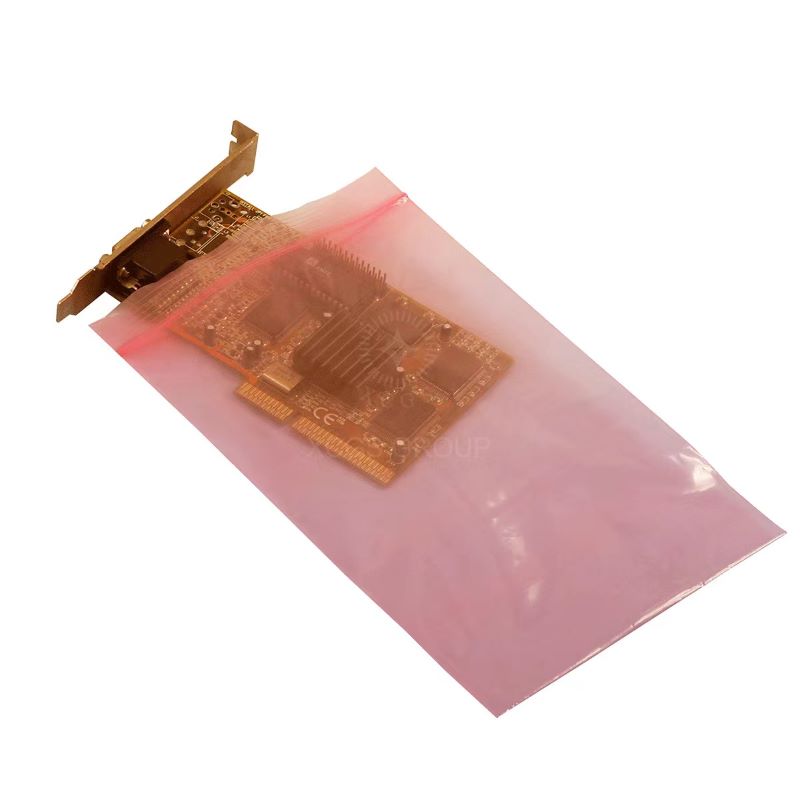FR1303 ESD PE Bag
Material: PE
Surface resistance:10^8-10^11ohm
Thickness: 0.02-0.1mm
Static decay rate:<2s
Suitable for PCB electronics products
Different sizes available
Products
Products DETAILS
FR1303 ESD PE Bag
ESD PE Bag – Complete Guide
An ESD PE (Polyethylene) Bag is a type of antistatic packaging designed to prevent electrostatic discharge (ESD) from damaging sensitive electronic components. These bags are made from polyethylene (PE) material with antistatic additives, which reduce static buildup and protect electronics from electrostatic fields.
1. What is an ESD PE Bag?
An ESD PE Bag is a flexible, lightweight packaging solution designed for temporary or low-risk ESD protection. Unlike ESD shielding bags, which block external electrostatic fields, PE bags are mainly used for:
Preventing static charge buildup on the bag's surface.
Reducing the risk of triboelectric charging (static generation due to friction).
Providing cost-effective protection for non-critical applications.
These bags do not provide full shielding against electrostatic fields but are commonly used in ESD-safe work environments (EPAs) where additional protection is in place.
2. How Does an ESD PE Bag Work?
ESD PE bags contain antistatic additives that prevent charge buildup on the surface.
Standard plastic bags can generate thousands of volts of static electricity.
ESD PE bags dissipate static charges to a grounded surface, reducing the risk of damaging sensitive electronics.
Most ESD PE bags have a surface resistivity of 10⁹ to 10¹² ohms/square, ensuring controlled static dissipation.
3. Types of ESD PE Bags
Pink Antistatic PE Bags
Best for: Preventing charge buildup.
Protection Level: Low – does not shield from external static fields.
Use Cases: Storing components in ESD-protected areas.
Clear/Transparent PE Bags
Best for: Identifying contents while maintaining antistatic properties.
Protection Level: Same as pink bags but with higher visibility.
Use Cases: Handling non-sensitive items in an ESD-safe environment.
Black Conductive PE Bags
Best for: Blocking electrostatic fields.
Protection Level: Medium – offers better protection than pink bags.
Use Cases: Storing semi-sensitive electronic parts.
4. Key Features & Benefits of ESD PE Bags
Prevents Static Buildup – Reduces triboelectric charging.
Lightweight & Flexible – Ideal for bulk storage.
Cost-Effective – Cheaper than metal shielding bags.
Heat-Sealable or Resealable – Allows secure closure.
Transparent or Colored Options – Different colors for easy identification.
5. When to Use an ESD PE Bag?
Storing electronics in an EPA (ESD Protected Area).
Packing non-sensitive parts (e.g., plastic components, cables, resistors).
Short-term transport inside ESD-safe environments.
As an inner liner for ESD shielding bags for added protection.
DO NOT USE ESD PE BAGS for shipping highly sensitive components like microchips, processors, or PCBs unless combined with additional shielding.
6. ESD PE Bags vs. Other ESD Bags
| Bag Type | Protection Level | Best For |
|---|---|---|
| Pink Antistatic PE Bag | Low | Preventing charge buildup in EPA areas. |
| Black Conductive PE Bag | Medium | Semi-sensitive components needing mild shielding. |
| ESD Shielding Bag (Metal-In/Out) | High | Blocking external static fields for ICs, PCBs. |
| Moisture Barrier Bag (MBB) | Very High | Long-term storage & moisture-sensitive devices. |
7. Best Practices for Using ESD PE Bags
Always use in an ESD-safe environment (EPA).
Do not place highly sensitive electronics directly in PE bags without shielding.
Seal the bag properly using zip-lock or heat-sealing.
Label bags with ESD-safe stickers for proper identification.








